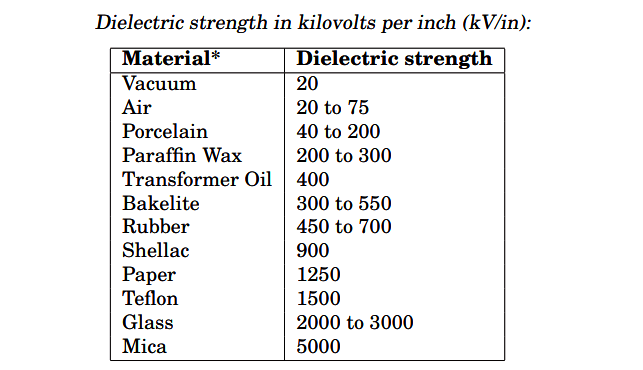The atoms in insulating materials have very tightly-bound electrons, resisting free electron flow very well.
However, insulators cannot resist indefinite amounts of voltage. With enough voltage applied, any insulating material will eventually succumb to the electrical ”pressure” and electron flow will occur.
However, unlike the situation with conductors where current is in a linear proportion to the applied voltage (given a fixed resistance), the current through an insulator is quite nonlinear: for voltages below a certain threshold level, virtually no electrons will flow, but if the voltage exceeds that threshold, there will be a rush of current.
Breakdown Voltage
Once the current is forced through an insulating material, the breakdown of that material’s molecular structure has occurred.
After the breakdown, the material may or may not behave as an insulator any more, the molecular structure having been altered by the breach. There is usually a localized ”puncture” of the insulating medium where the electrons flowed during the breakdown.
The thickness of an insulating material plays a role in determining its breakdown voltage, otherwise known as dielectric strength. Specific dielectric strength is sometimes listed in terms of volts per mil (1/1000 of an inch), or kilovolts per inch (the two units are equivalent), but in practice, it has been found that the relationship between breakdown voltage and thickness is not exactly linear.
An insulator three times as thick as a dielectric strength slightly less than 3 times as much. However, for rough estimation use, volt-per-thickness ratings are fine.
Dielectric Strength

* = Materials listed are specially prepared for electrical use,
Review
- With a high enough applied voltage, electrons can be freed from the atoms of insulating materials, resulting in current through that material.
- The minimum voltage required to ”violate” an insulator by forcing current through it is called the breakdown voltage, or dielectric strength.
- The thicker a piece of insulating material, the higher the breakdown voltage, all other factors being equal.
- Specific dielectric strength is typically rated in one of two equivalent units: volts per mil, or kilovolts per inch.
